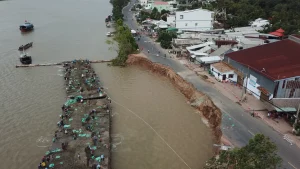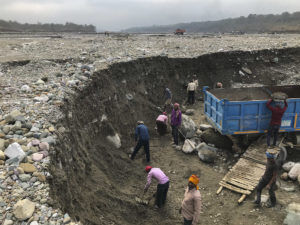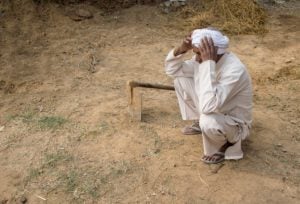Editor’s note: In light of increasingly volatile seasons, the unquantified effects from hydropower, and continued sand mining, mainland Southeast Asia finds itself combating ever more mercurial sandbanks. For the highly populated Mekong Delta region of Vietnam, homes being washed away has become a regular facet of the wet season. But the effects of overdevelopment on the Mekong are felt across the Mekong basin. In Cambodia, the recent consequences have been stark: in May, Vannak Si and Bun Thoeun Srey Leak, both 12, died when a bank gave way in Kandal province, on the border with Vietnam. As the land beneath river-dwellers’ feet becomes ever more unstable, the sand mining and concrete industry defy solutions, as mainland Southeast Asia continues with breakneck development.
When a riverbank subsided and gave way four years ago, Tran Van Bi’s house collapsed into a river in Vietnam’s Mekong Delta. Everything his family had accumulated over 32 years was gone in an instant.
“At that time, when I heard the sound of screaming, I ran back, only to see the roof of my house sinking into a fast-flowing stream,” said Bi, 60, whose old house was next to Vam Nao River in My Hoi Dong commune, An Giang province.
“I ran to find my wife and children and then like a lost soul, I didn’t know what to do.” Fortunately, his family members were safe.
The river swallowed a total of 14 houses that day. The subsidence forced another 106 households to relocate.
Bi blamed sand mining in the area for the loss of his house. Watching and hearing sand dredgers chew endlessly through the riverbed by his old house had become a familiar part of his life. Looking back, he realised the signs of a pending tragedy had been there for some time. The nearby mudflats had disappeared and the water flow by his home had increased dramatically.
For years, the Mekong Delta has suffered from rampant coastal and riverbank erosion due to diminishing amounts of suspended sediment and sand in its waterways. Experts blame upstream hydropower dams, which have trapped sediment, as well as excessive sand mining along the Mekong, especially in Cambodia and Vietnam.
This means the Mekong Delta, formed by sediment over the past 6,000 years, is effectively disintegrating.
More than 600 hectares of riverside and coastal land is lost every year in the delta due to erosion, according to Le Anh Tuan, associate professor at the Research Institute for Climate Change (DRAGON Institute-Mekong) of Can Tho University. He warned of “irreversible damage” if sand mining in the area is not restricted.
Paying a heavy price
Over the past decade, five Mekong Delta provinces – An Giang, Dong Thap, Can Tho, Vinh Long and Soc Trang – have issued permits to mine 114 million tons worth of sand reserves. That is equivalent to nearly seven tons for each person living there. The true quantity is thought to be much higher because illegal sand mining remains common in the Mekong Delta.
Most residents, however, never get close to this sand, or the money it brings in. Instead, families measure sand mining in lost houses and fortunes.
Official statistics show that between 2018 and 2020, 1,808 houses in the Mekong Delta sank into rivers or the sea due to erosion. That’s the equivalent of five villages being completely wiped out, with damage topping VND 200 billion (USD 8.6 million).
Families living in areas with the most sand being sucked out of the river are also those most at risk of becoming homeless. An Giang and Dong Thap are the two provinces that extract the most sand in the area, at 5.3 million and 5.5 million cubic metres annually.
Unsurprisingly, these provinces also lead in the number of houses threatened by subsidence that need to be relocated ― 5,300 in An Giang and 6,400 in Dong Thap.
Chasing the miners away
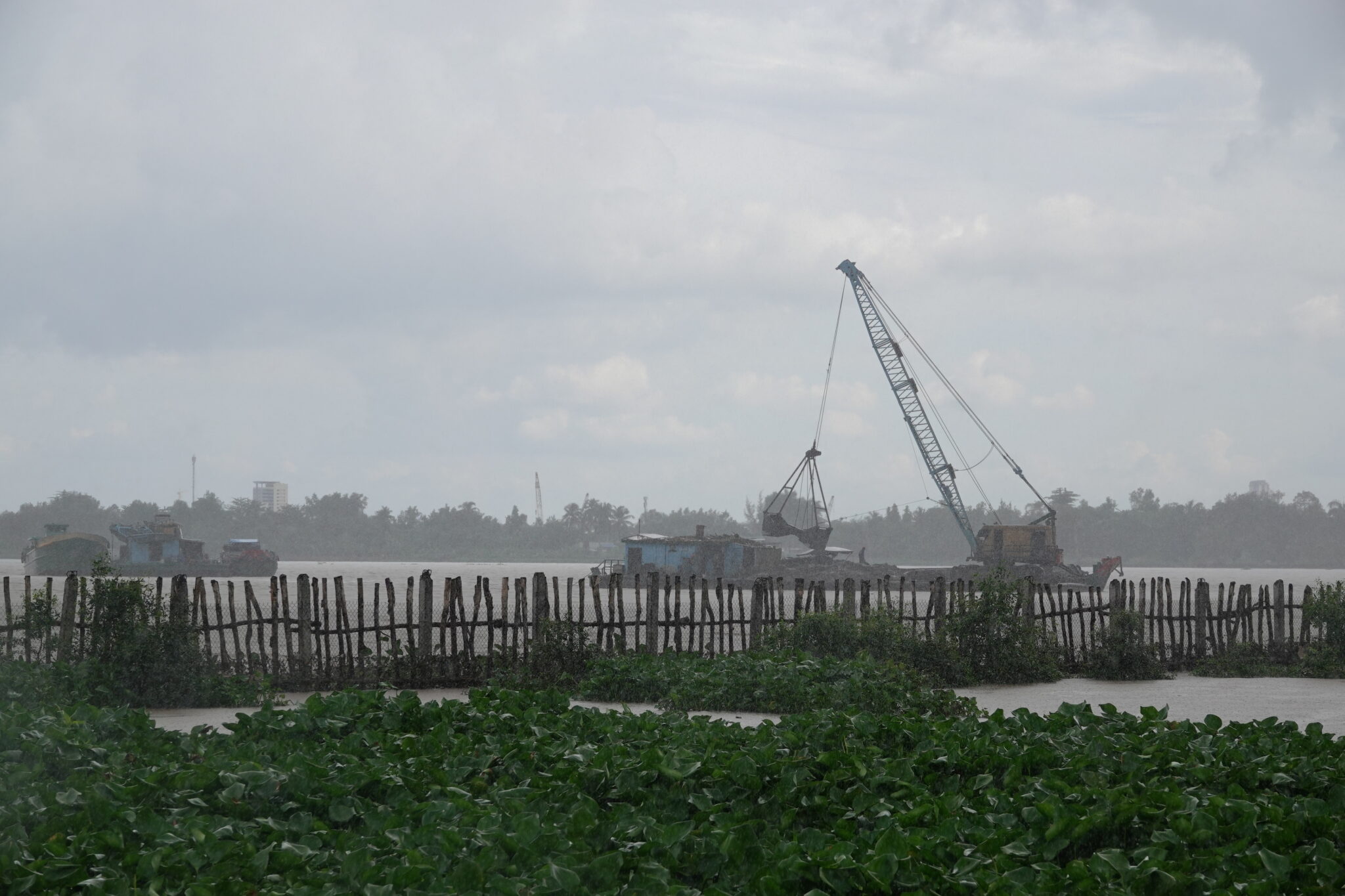
Despite the sound of torrential rain on the Hau River, the roar of a sand dredger is unmistakable, disturbing the peace of a stretch of river bordering Vinh Long province and Can Tho city.
Nearer to the shore, other dredgers are pulling up sand. The sight is unsettling – every time the crane’s giant arm stretches out and drops its large bucket into the river, it’s like a landmine exploding. The dredger’s engine roars, black smoke spews out and buckets of sand are lifted from the water by the crane. Then the bucket is slowly moved sideways until it releases the sand into containers on barges parked alongside.
As soon as a barge is full of sand, the pilot pulls up the anchor and leaves. Immediately, another barge takes its place. Around the sand mining area, dozens of other barges are moored, waiting their turn.
About 100 metres away lies Son islet, a small island in the middle of the Hau River in Binh Thuy district, Can Tho city. Local people have put a long row of bamboo stakes into the ground to form a wall, or dyke, in an effort to prevent their island from disappearing into the river and to protect their fish ponds.
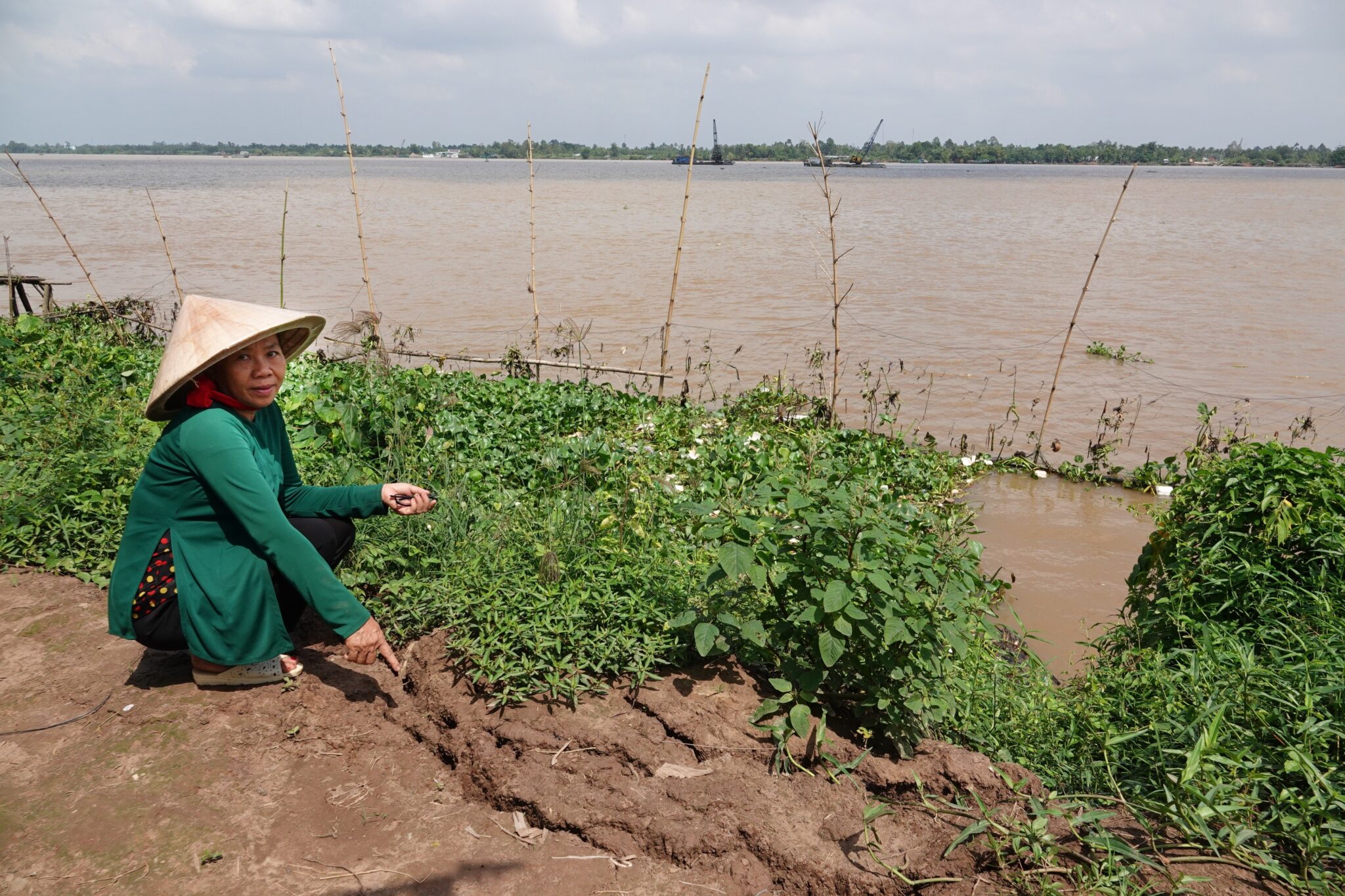
Pointing to the cracks in the dyke, Phan Kim Ngan, a 57-year-old rambutan farmer, said subsidence had caused many sections of the dyke to break.
“Everybody on the dunes opposes sand mining since it causes erosion, but nothing has changed,” Ngan said. “Can Tho doesn’t allow mining anymore, Vinh Long still allows 3-4 dredgers to operate, and they have even used a large pump they drop to the bottom of the river to suck up the sand.”
Angry residents on Son islet have at times resorted to getting in their boats and chasing away the dredgers. One time, some of the sand miners attacked a villager, leading to a bloody fight. Local residents then immediately took up the matter with the local government, but eventually, they decided against pressing charges.
“People don’t want to break the law, but they’re so angry that they had to run out and chase away those miners,” said Pham Hai Dao, a 65-year-old farmer who lives on Son islet. He has had to move house five times due to erosion and has lost two thirds of his farming land. “People here are not afraid,” he said.
Although each sand miner has to register the number of mining machines they use, very little public data is available that would allow communities and civil society to monitor their operations. There is no centralised regulatory body tasked with overseeing the entire industry.
Establishing a paper trail independently to prove violations is nearly impossible. Sand mining companies do not have to disclose the extracted volume, or show sales ledgers or revenue to anyone outside the authorised government inspectors, who do not make that information public.
Tax payments, revenue and profits are self-declared and reported directly to the tax authority by the company and, again, are not accessible to the public. The only way to monitor these activities is by watching, and the only avenue citizens have to objecting is to shout at the miners from the riverbanks, or to try to chase them away. Many remain silent, fearing revenge attacks.
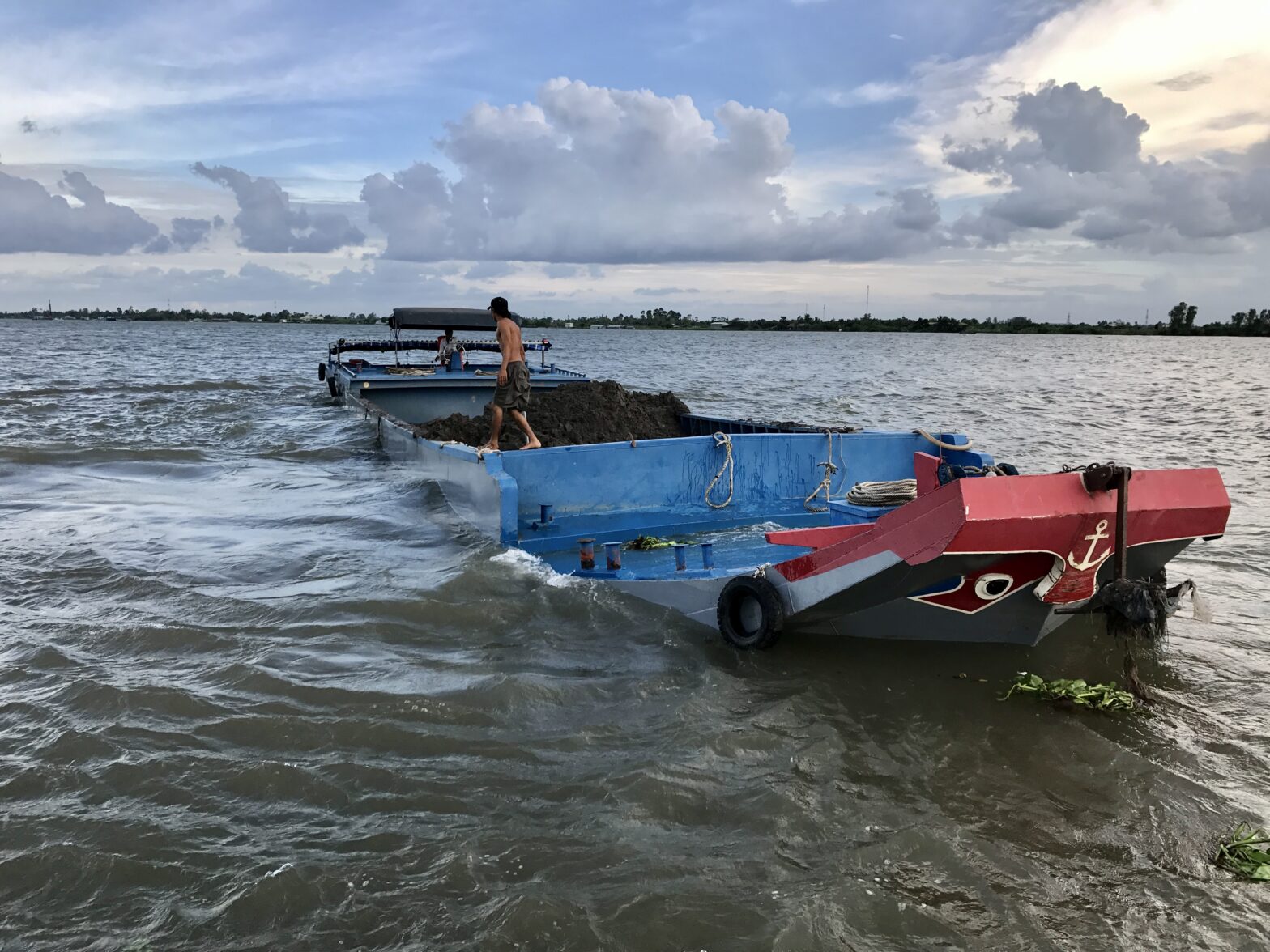
Mekong sand mining difficult to control
There is a saying in Vietnamese to describe the efforts by regulators to crack down on illegal sand mining: “It’s like keeping a toad on a plate.”
Under-reporting the amount of sand extracted and falsifying records is rampant in many companies, and it is something that “is very difficult to control,” according to Nguyen Chi Kien, deputy director of the Department of Natural Resources and Environment in Can Tho city.
Companies have been known to smuggle sand across provincial borders to evade both authorities and reporting requirements. They often operate at night to evade regulators.
Kien has been involved in many exasperating games of cat and mouse in an effort to prevent sand smuggling. Once he discovered that dredgers from Vinh Long province had started to mine near Can Tho City. When authorities came to investigate, the miners and their equipment immediately retreated towards Vinh Long, putting them outside the authorities’ jurisdiction. “This is a truly challenging task,” Kien said.
In 2020, Can Tho’s waterways police inspected 27 sand mining operations and discovered many violations, resulting in two sand mining operations being shut down and three people charged and prosecuted.
There is also a black market for sand originating from Vietnam. Estimating its exact size would be impossible. But a United Nations database that compares Vietnam’s sand export data with the destination countries’ corresponding import data suggests that large quantities of sand are bypassing official trade channels.
Vietnam reported earning USD 212 million from sand exports from 2011 to 2020. Over the same period, other countries reported that sand imports from Vietnam were worth nearly USD 705 million – that’s 3.3 times higher than Vietnam reported. The largest gap was recorded in 2014, at USD 120 million. After Vietnam banned sand exports in 2017, only pre-existing export agreements could continue. The gap then became much smaller.
Vietnam’s General Statistics Office said these figures rarely match due to inconsistencies in the timing, scope and values applied by each country in their calculations. Additionally, some shipments may be double counted if they pass through an intermediary country before reaching their final destination.
In the eyes of Ha Thanh Giang, the owner of two large sand mining operations in Can Tho, the environmental regulations are a burden. He had to cease operations at one of his mining sites after local authorities ordered its closure in November 2021 without providing a reason.
“I had to appeal for an extension because I had already signed a contract to supply 700,000 cubic metres of sand to a construction project outside the province,” said Giang. “Now that the operation is shut, I’ll have to indemnify [pay] my client.
“There is a great demand for sand as every province needs millions of cubic metres per year,” Giang added. “Then, if you don’t exploit it, where will you get sand to meet that need?”
Despite government efforts to regulate the price of sand at between VND 56,000 and 80,000 per cubic metre (USD 2.42-3.46), the market price starts at VND 280,000 per cubic metre (USD 12.13).
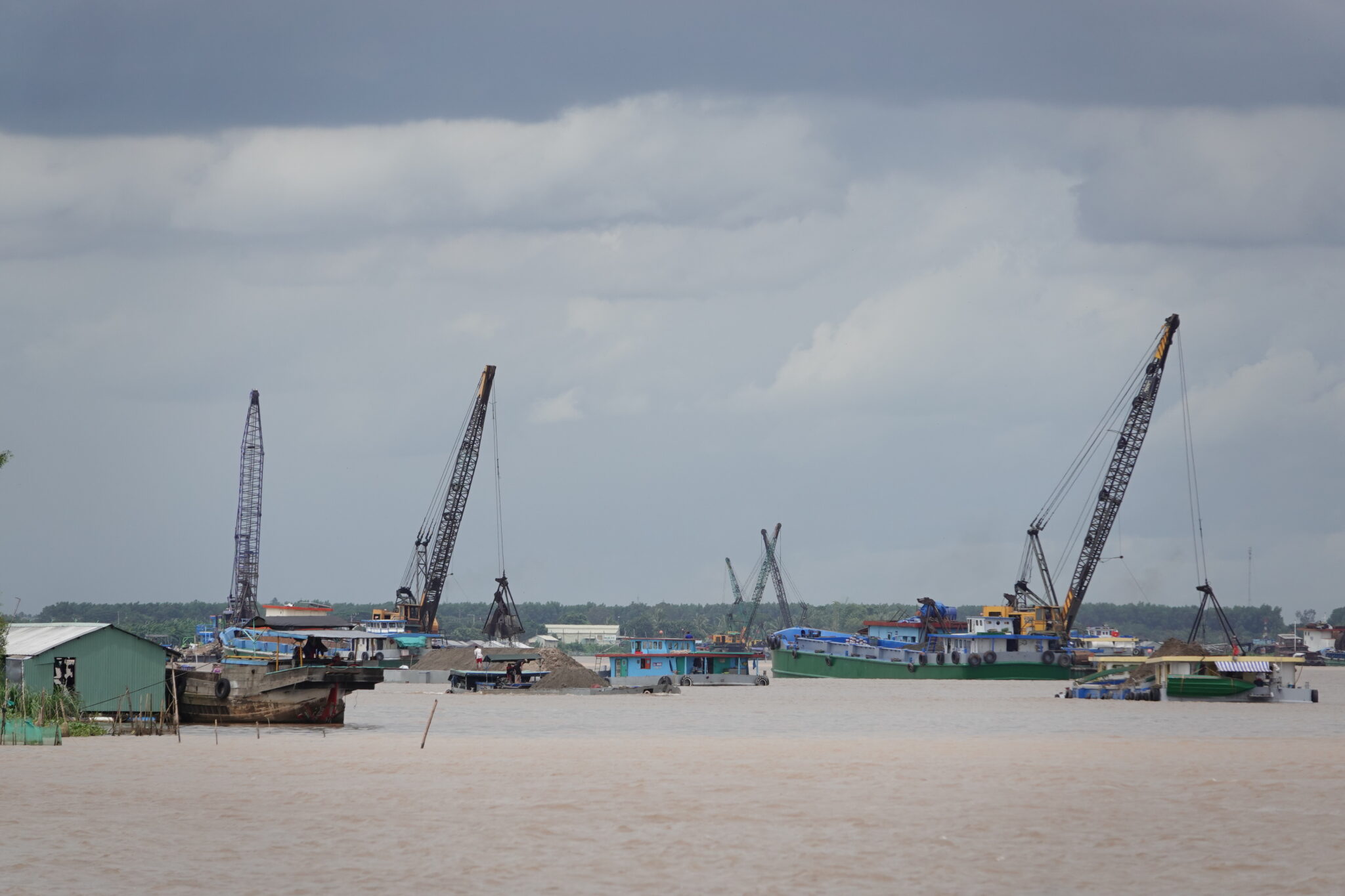
Balancing the demand
The high demand for sand in the Mekong Delta can be explained by the fact that it is a low-lying area that is gradually sinking, according to Tran Anh Thu, vice-chairman of the An Giang Provincial People’s Committee. Because of this, infrastructure such as roads and buildings constantly need to have their foundations raised to stay above flood levels. As long as no alternative sources of materials are available, the demand for sand will remain strong. “The key is where and how sand is mined. How to dredge so as to limit negative effects,” said Thu. “The drop in sediments and sand stock shouldn’t be reasons to ban sand mining.”
In An Giang, management of sand mining is divided into three groups. Areas at risk of subsidence – the first group – will stop issuing permits and not renew previously issued permits. The second group comprises areas where sand mining is licensed through mining tenders, but mining capacity is limited. At present, this group has 11 licensed miners with a capacity of nearly 5.3 million cubic metres per year. The third group is dredging and correcting the supply flow at alluvial flats on the river. An Giang has seven such dredging areas, providing up to 80% of sand for the province.
Lai Hong Thanh, deputy director-general of the Department of Geology and Minerals, said sand mining in the Mekong Delta would not stop while the demand for sand remains huge, at up to 100 million cubic metres of sand per year.
The government has allocated VND 12 trillion (USD 516 million) since 2016 to tackle riverbank and coastal erosion at sites totalling 375km in length in the Mekong Delta. Along with banning the export of sand, the state has issued regulations that aim to prevent excessive dredging. Vietnam is also looking into producing artificial sand.
Experts and residents, however, remain concerned. Sand is only considered a common construction material under the Mineral Law, and licensing is issued by individual provinces.
Nguyen Huu Thien, an independent expert on the Mekong Delta’s ecology, argues this is a narrow view because sand also plays a role in maintaining territory. Sand mining should be managed at an inter-provincial level, to balance the impact across the entire delta, he said.
“If we continue to exploit sand at the current rate, we may have to redraw the map of the Mekong Delta in the future when the coastline is eroded and the riverbank is deformed,” Thien warned.
Locals bear the consequences
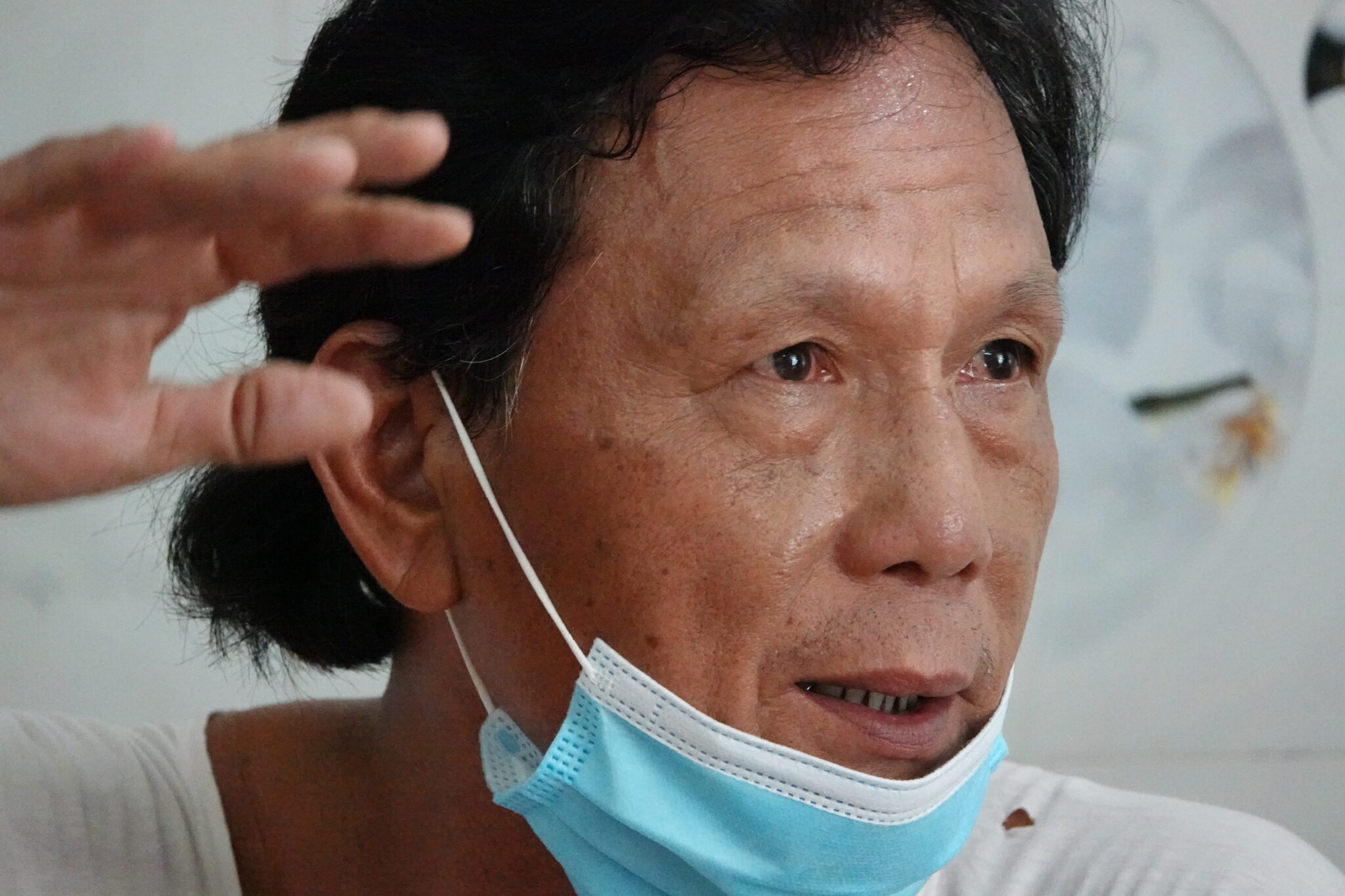
Meanwhile, the lives of people displaced by riverbank erosion remain uncertain. Tran Van Bi’s family, who lost their house to the Vam Nao River four years ago, were eventually resettled. From two houses worth VND 6 billion (USD 260,000), they were moved to two plots of land and received VND 100 million (USD 4,328) in compensation.
Starting life over again was difficult. Their old house also served as a shopfront for their pork business. Relocation meant they had to rent a shop in a market to continue their trade. Then, Covid-19 hit.
Some did not live long enough to move to their new houses. Nguyen Van Tiet and his mother Le Thi Choi both died before the government allocated new land to them – three years after losing their house. By the time the new house was ready, it became the burial site for Tiet and Choi.
Of the 106 households forced to relocate due to subsidence along the Vam Nao River, 25 have returned to their old houses despite the imminent danger, refusing to live at the relocation site. Dozens of others, due to difficult circumstances, have left their hometowns and migrated to other provinces to work.
“I can’t move because my old house is near the road and the market, where I sell groceries and drinks. My daily earnings are about VND 50,000 (USD 2.10), enough to live through a day,” said To Thi Kim Hong, one of the residents. “If I move to a residential area, I won’t know what to do to make ends meet.”

Statistics show that in five provinces and cities – An Giang, Dong Thap, Can Tho, Vinh Long and Ca Mau – up to 20,000 houses are in subsidence-prone areas and need to be relocated. This number of houses would be enough to establish 57 new villages. The total proposed relocation cost amounts to VND 5 trillion (USD 215 million).
Back at Son islet where erosion remains a constant threat, villagers continue to fight for their land. “We know that sand is important for development, but we cannot sit back and watch a scorpion scoop it up every day, while our land is eroded and trees are washed away,” said Pham Hai Dao, the villager who had to move house multiple times due to erosion.
“They scoop up the sand for sale and we bear the consequences.”
This story originally appeared in Mekong Eye and is republished here with permission. It was produced under the Mekong Data Journalism Fellowship jointly run by Internews’ Earth Journalism Network and the East-West Center. Its Vietnamese version was published in Thanh Nien, a newspaper based in Ho Chi Minh City. Data visualisation is provided by Thibi.
